- Our Insiders
- Choral & Song
- Instrumental
- Great Recordings
- Musical terms
- TV and Film music
- Instruments
- Audio Equipment
- Free Download
- Listen to Radio 3
- Subscriber FAQ
- 2023 Awards
- 2024 Awards

Who were the Three Tenors? A guide to Pavarotti, Domingo and Carreras
When Plácido Domingo, Luciano Pavarotti and José Carreras took to the stage together before the 1990 World Cup Final, they changed the course of classical music - and, arguably, football too
Rob Ainsley
The soundtrack of everyone’s life in summer 1990 was Luciano Pavarotti singing Puccini’s ‘Nessun’ dorma’.
And, probably, the Three Tenors concert on 7 July, the eve of the World Cup final of Italia 90: a light-hearted showcase of him, Plácido Domingo and José Carreras beautifully performing the great and the good of the tenor repertoire, individually and together.
Who were The Three Tenors?
The ménage à trois proved a huge, unexpected success. It spawned the biggest-selling classical album ever, and multi-million pound tours. It shook up classical marketing. Crossover albums, Vanessa-Mae, Sarah Brightman, Russell Watson, ‘stadium tenors’, ‘popera’... it’s The Three Tenors you should thank. Or blame.
But despite subsequent accusations of selling-out, tax fraud, and inappropriate gum-chewing, The Three Tenors phenomenon remains how it felt that starry night at Rome’s Baths of Caracalla: a glorious celebration of high art and popular song, astounding vocal technique, and a dash of amiable larking about.
- How Puccini's Madam Butterfly catapulted Pavarotti to stardom
And of football, of course, opera’s sporting, rough-diamond cousin. They’re clearly related.
Both are about emotion, triumph and tragedy, and both involve hugely paid, temperamental international talents unconvincingly pretending to mortal wounds on a high-profile stage. There are plenty of tears in both, too – few can have forgotten how England’s Paul Gascoigne cried as his team got knocked out of that 1990 tournament…
- Football-mad musicians: 6 of the best
How did The Three Tenors form?
Back then, though, the classical/football link seemed tenuous. Opera was high-culture, football was low-status, with the Heysel and Hillsborough stadium disasters still raw in the memory. But the BBC’s use of Pavarotti’s rendition of ‘Nessun’ dorma’ as the Italia 90 theme helped elevate the sport.
In 1989, BBC producer Philip Bernie applied Puccini ’s majestic aria to a clips compilation from previous world cups. He loved the defiant climax of that penultimate high B, the ‘-ce-’ of ‘vincerò’ (‘I’ll win through’) – Pavarotti, like everyone, milks the final two notes far longer than is indicated in the score; how could anyone resist?
- Luciano Pavarotti: The best recordings
- What are the lyrics to 'Nessun Dorma' from Puccini's opera Turandot?
According to Bernie’s blog, ‘This seemed to me to fit perfectly, both in terms of the word and the intensity, with an especially memorable image from Italian football: when Marco Tardelli scored the crucial goal in the 1982 World Cup final for Italy against Germany, he ran away, arms spread and mouth wide open in utter exultation.’ The decision to keep using it for Italia 90 was evidently Brian Barwick’s, then head of sport – presenter Des Lynam had apparently wanted the then-better-known ‘O sole mio’.
The single reached No. 2 in the pop charts; England finished No. 4 in Italia 90, losing to the hosts the night of the concert. For a while it felt classical music was going mainstream, though it’s never reached those heights since. Nor have the England football team.
Were The Three Tenors football fans?
Football links were appropriate. All three tenors were fans (Domingo, Real Madrid; Carreras, their arch-rivals Barcelona; Pavarotti – a good enough goalkeeper in his youth to consider being professional – Juventus).
- Shostakovich and football: how the beautiful game shaped the composer's life and music
Immediately before the 1990 concert, they were avidly watching that England-Italy match. Pavarotti said it was probably good that Italy had failed to make the following day’s final, as it would have distracted him from the music.
- David James: why the footballer trains to Beethoven's Ninth Symphony
Genuine friends, and respectfully competitive, the Tenors were clearly distinct personalities. That was part of the charm that endeared them to everyone from jaundiced critics to your best-friend’s mum.
Domingo, born 1941, was the great all-rounder, the profoundest musician of the three. His voice, as richly coloured and characterful as a Rembrandt, has done everything from native Spanish pop to Wagner ; increasingly familiar with baritone roles, he’s conducted too.
- The 20 greatest tenors of all time
Pavarotti (1935-2007) was an all-rounder only physically: naturally dominant in onstage antics and in vocal presence, especially up the top, he smartly stuck throughout his career to home turf, Italian repertoire that suited his gleaming silvery voice.
‘The other guy’ (according to a running gag in the US comedy Seinfeld ) was José Carreras – more accurately ‘Josep’, a proud Catalan. Born 1946, he was the youngest, smallest, least imposing of the three, with debate over how well his vocal cords had withstood chemotherapy; but his lyricism and sincerity was never doubted.
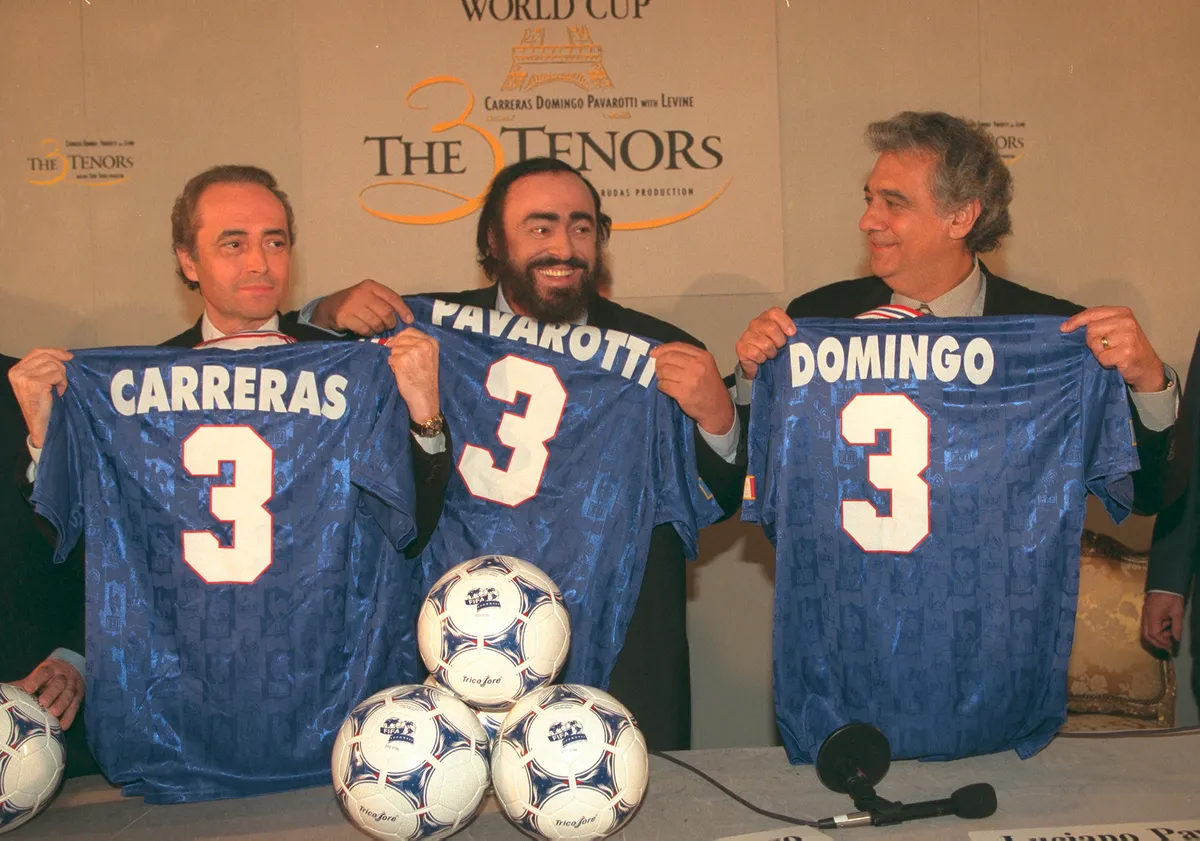
The Three Tenors concert, according to Carreras’s recent autobiography, was his idea. When he was diagnosed with leukaemia in 1988, Domingo and Pavarotti’s support was immediate. A year later, having beaten off the disease, he revived an idea floated ten years before to commemorate the tenor Giacomo Lauri-Volpi (1892–1979): getting together onstage. With Italia 90, and to celebrate his return to health, its time had come. Pavarotti and Domingo gladly agreed.
But it’s the promoter Mario Dradi – Carreras’s manager in Italy – who usually takes the credit. Certainly, he made that first concert happen.
He brought in Zubin Mehta as conductor (though the first Mehta knew about it was reading a newspaper, which he dismissed as gossip). He battled red tape and obstructive officials – ‘the biggest problems were the political problems, in the sense that everything is a political problem in Rome’, he said.
Dradi also received endless suggestions for adding glitz to the staging. An American MC? Scoreboards for each tenor? Individual platforms rising and falling during performance? Wisely, he ignored them all.
Deciding the programme of individual aria favourites had been an easy joint task. But Mehta insisted on a threesome too: ‘I said if you don’t sing together, you might as well sing in three different places’. There being ‘no trio that made sense’ in the literature, they commissioned one from Argentinian composer Lalo Schifrin, a 20-minute encore of the tenors’ favourite popular songs – artistically it was a tricky task, but then Schifrin had written the theme to Mission Impossible .
After the individual showpieces, the tenors could jokingly compete, in ‘Memory’ from Cats , ‘Ochi tchorniye’, ‘Tonight’ from West Side Story , ‘O sole mio’, ‘Nessun’ dorma’...
The concert itself delighted the 6,000 audience – it’s said 100,000 tried to buy tickets – plus millions of worldwide TV viewers. The concept of a massive, open-air, amplified, classical-crossover concert had proved a triumph.
Mehta afterwards, reflecting general opinion, stated ‘I don’t think this concert will ever happen again’. For once, his artistic judgement was wrong.
How many copies did The Three Tenors album sell?
Classical releases typically sell in the hundreds; a thousand or two if you’re lucky. Decca’s recording of The Three Tenors concert sold over ten million, surprising everyone – especially Mehta and the tenors, who had signed away their royalties for a flat fee. (Pavarotti’s former manager Herbert Breslin, in a caustic memoir unflattering to everyone, claimed it was $300,000 each; Mehta however says there were ‘completely over-the-top rumours, mostly about the fees’, and that ‘we didn’t make a penny from it’.)
But suddenly, The Three Tenors concept was a licence to print money – even more than Pavarotti’s late-night poker sessions which, Carreras recalls, used photocopied dollar bills for stakes. When the 1994 World Cup came round, in the US, another eve-of-final concert was inevitable. And the artists made sure they were well paid: $1.5m apiece, it was rumoured.
Tibor Rudas, Pavarotti’s manager, produced it this time. This Los Angeles concert was even bigger and more populist than Rome’s. It included ‘My Way’ and ‘Singin’ in the Rain’, to the bemusement of audience members such as Frank Sinatra and Gene Kelly.
Pavarotti, chewing gum throughout, was criticised by some for not taking it seriously. But it proved even more lucrative; indeed, in the American-speaking world, it’s ‘the’ Three Tenors concert.
And so it went on. A Christmas special, featuring ‘Jingle Bells’; world tours; more World Cup concerts. Carreras says it seemed you couldn’t have an international football tournament without their presence.
Were they getting too popular? Pavarotti riposted there was no such thing: ‘music should be like sport, for everyone’. They were out-earning even footballers. Laughed Pavarotti, ‘Good money? By God, it’s good money!’.
Popularity led to parody, on primetime TV and beyond. In a 1998 German children’s book, Am Südpol , The Three Tenors visit the South Pole to perform for penguins, because everyone else has had enough. The penguins, however, are more interested in the Spice Girls and ticket scalping.
What happened to The Three Tenors?
The pop/classical envelope wasn’t the only one being pushed. Also, allegedly, were plain ones, into back pockets, stuffed with cash. The 1990 concert had been, in principle at least, for charity; Dradi insisted it had raised half a million pounds for good causes.
But now, German producer Matthias Hoffmann was in financial control. He believed charity begins at home: having hidden £6m from the taxman, he was convicted of fraud in a German court in 1998 and got five years in prison.
When was the last Three Tenors concert?
The last Three Tenors concert was in 2003. During the final years, Carreras – says his autobiography – was social middleman between Domingo (increasingly busy with heavyweight musical ventures and new roles – including, winningly, himself, in The Simpsons ) and Pavarotti (who was easing up, partly because of bad health, partly to enjoy celebrity hanging-out). The Italian died of pancreatic cancer in 2007, his voice much missed, his flaws acknowledged, his well-maintained wine-women-song-and-food persona hard to dislike.
How did The Three Tenors change classical music?
By showing there was a vast, hitherto untapped, audience for slickly produced, audience-friendly ‘classical lite’, the success of The Three Tenors changed the face of classical music marketing.
Marius Carboni, then a press officer with EMI and now a university lecturer in marketing, did his PhD thesis on how classical labels adapted the methods of pop marketing in their wake. EMI, he says, had started the snowball rolling in 1989 with its then-innovative (for classical) campaign for violinist Nigel Kennedy ’s Vivaldi Four Seasons : they targeted radio stations, non-classical magazines such as Q , and London Underground posters.
- The best recordings of Vivaldi's The Four Seasons
After The Three Tenors, Carboni says, record labels reorganised themselves into ‘strategic classical’ (big-budget popular campaigns) and ‘core classical’ (‘normal’ releases, subsidised by the strategic classical albums). He gives the more recent example of Tasmin Little’s 2008 album The Naked Violin , marketed online as pay-what-you-like, following on the example of Radiohead’s 2007 album In Rainbows .
Every crossover TV-tie-in album, every talent-show ‘opera singer’ who’s never actually been in an opera, every bright young genuine classical talent whose hairstyle is as important as their technique... it all stems from The Three Tenors. They effectively ‘went viral’ before the internet had even arrived; now, classical blockbusters – often niche releases too – depend as much as pop on websites, downloads and social media.
- How classical crossover has fuelled creativity
But what about The Three Tenors themselves? How do people remember that initial concert in Rome? A quick canvas of opinion on social media provides a wealth of feelgood memories.
Virtually every comment finishes with a smiley face, as did each of the singers after the 1990 concert – their performance certainly beat the shabby Germany-Argentina final that followed, an ugly fight during which a game of football occasionally broke out.
And, despite the subsequent bluster, hype, dodgy dealings, and sometimes questionable artistic choices, The Three Tenors still make us, too, smile – at their voices, their personalities, their fearless populism. Plácido, Josep, Luciano, we salute you for that unforgettable summer. You played a blinder.
Pics: Getty
Share this article
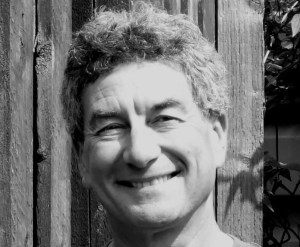
- Privacy policy
- Terms & Conditions
- Cookies policy
- Manage preferences
- Skip to main content
- Keyboard shortcuts for audio player
Deceptive Cadence
- Issues & Ideas
- Music Makers
- Now Playing
- NPR Classical
How The Three Tenors Sang The Hits And Changed The Game

Anastasia Tsioulcas

Placido Domingo, José Carreras and Luciano Pavarotti at Dodgers Stadium in Los Angeles, with conductor Zubin Mehta. Courtesy of the artists hide caption
Placido Domingo, José Carreras and Luciano Pavarotti at Dodgers Stadium in Los Angeles, with conductor Zubin Mehta.
The Three Tenors joined to conquer. When this trio of famous opera singers — José Carreras, Placido Domingo and Luciano Pavarotti — gave a one-night-only show at Los Angeles' Dodger Stadium on July 16, 1994, it was a massive spectacle watched by a billion people worldwide. More than that, the Three Tenors phenomenon permanently altered how a large amount of classical music is presented, packaged and sold.
Timed to coincide with the Brazil-Italy World Cup final being held the next day at the Rose Bowl in nearby Pasadena, the live concert was filmed for TV broadcast in more than 100 countries. It was enough of a draw that it was shown either immediately before or after the big game in most places.
The stadium was filled to capacity for the debonair Carreras, heroic Domingo and golden Pavarotti. The VIP list was a star-studded 1990s dream cast. Former President George H.W. Bush and his wife Barbara were in attendance, as were Tom Cruise, Arnold Schwarzenegger and David Hasselhoff (don't discount what an international megastar he was back then). Gene Kelly and Frank Sinatra were on hand, too — smiling and nodding indulgently as the three opera singers gingerly made their way through "Singin' in the Rain" and "My Way."
Backed by the Los Angeles Philharmonic and the Los Angeles Music Center Opera Chorus and conducted by Zubin Mehta (who also did much to shape the program), with arrangements by Hollywood legend Lalo Schifrin , the trio winged their way jovially, if not terribly convincingly, through a string of haphazardly linked opera arias, Neapolitan songs and easy-listening favorites for a crowd of 56,000.
All three pairs of the tenors' eyes were glued to music stands through the musical theater tunes and American pop standards. The words for the English-language selections were hidden under nearly impenetrable accents. Through most of the show, Pavarotti chomped gum insouciantly.
"Beaming, smirking, sweating, bellowing, selling, blowing kisses, waving hankies, punching the air with victorious fists and the sound system with climactic not-too-high notes" is how Martin Bernheimer of The Los Angeles Times put it .
In the end, none of that mattered one iota. The Three Tenors in Concert 1994 was an astonishing success on every level. Well before Carreras, Domingo and Pavarotti got to their grand-slam encores — the Verdi arias "La donna è mobile" and "Libiamo ne' lieti calici (Brindisi)" (which Atlantic Records had released as a single before the live date, and which went immediately to No. 1 on the European charts), followed by Puccini 's "Nessun dorma" — all the hard work had paid off. The CD and DVD versions of the concert, which the Warner label is rereleasing for this anniversary, went on to sell more than 8 million copies worldwide.
But how had it come to be? And was the Three Tenors phenomenon, as conductor Zubin Mehta dubbed it at the time, only just "like a comet " — having its blaze of glory and then vanishing without a trace?
Hardly. Not only did the Three Tenors become a global pop-culture touchstone, but their albums, tours and videos shifted an entire segment of the music industry for good.
The Backstory
The 1994 Los Angeles concert wasn't the first time the three singers and Mehta had joined forces. In 1990, a concert presenter from Bologna, Italy, Mario Dradi, had brought the trio together in Rome for a concert at the Baths of Caracalla. According to a New York Times review of that concert, Pavarotti said the three had been asked "at least 50 times" to appear together before, but had always said no.
What drew them into the Rome performance, they said, was a twofold impulse: to welcome Carreras' return to performing after defeating leukemia , and the tie-in to the 1990 World Cup, because football is a particular passion for them all. Carreras is an avid Barcelona fan; Pavarotti played on his hometown team in Modena, Italy, as a young man; and Domingo, who has occasionally played in charity games, is a fervent Real Madrid supporter who was also tapped by FIFA a couple of years ago to serve on its ethics committee.
It was Hungarian-born impresario Tibor Rudas, who was already Pavarotti's promoter, who created the Los Angeles spectacle. (Dradi was on the outs after he had sold the recording rights to the Rome show to the Decca label with no royalties going to the artists, only a fixed performance fee. Domingo in particular was said to have been furious : The Decca release was a worldwide smash in its own right that triggered the original Three Tenors craze.)
Rudas — a born showman who had long worked in bookings in both Atlantic City, N.J., and Las Vegas — did his best to create an outsized event, all meant to help the audience forget that they were in a baseball stadium. His five-story set, inspired by the architecture of Budapest, was built in Hungary and assembled at an Air Force hangar in California. It included massive amounts of suspended greenery, Hollywood production-house painted backdrops, and even waterfalls that had to be turned off at the beginning of the concert due to their noisiness. According to Rudas, the whole enterprise was so expensive that the ticket sales wouldn't cover his costs.
Rudas wasn't the only impresario hovering around after the runaway success of Rome four years before. Both Carreras and Domingo had been working with German promoter Matthias Hoffmann, who also wanted in on the action. The single most telling moment in a hagiographic behind-the-scenes documentary that accompanies the LA concert film is when Domingo recounts how the performance came to be. Domingo says he went to FIFA himself to discuss an encore Three Tenors/World Cup extravaganza for Los Angeles in 1994, only to be told: "Mr. Rudas has already the rights."
On camera, Domingo gives an elaborate shrug: "Well, fine, he has the rights, here we are." And one can't help but read some financial meaning into this account — securing those rights meant having a huge monetary stake in its success. And make no mistake, these spectacles, as a franchise, represented enormous money. After the LA concert, they soon appeared in arenas and other huge venues around the world, from Tokyo to Göteborg, Sweden, with Hoffman finally at the helm after having bought Rudas' set and staging.
"Is it good money ?" Pavarotti once asked a reporter rhetorically about the lure of the Three Tenors billing. "By God, it's good money." Each tenor was paid about $1 million plus royalties for the Los Angeles show. (That would be worth approximately $1.6 million today.) When they headed out on their worldwide tour two years later, the three singers were earning $500,000 per concert apiece — about $800,000 in today's dollars — plus a percentage of all the merchandise sales and royalties. ( James Levine , who replaced Zubin Mehta on the later tours, earned a flat $500,000 per performance.)
For the Los Angeles concert, VIPs were seated in the infield, and tickets went for between $15 and $1,000 apiece. The New York Times quoted Rudas as saying that the ticket income for the LA show alone — not even counting the copious amount and variety of artist merchandise for sale at the venue, ranging from seat cushions to autographed baseballs — was a record-setting $13.5 million . The Los Angeles Times reported the concert gross as $12.5 million — still a huge number — and pointed out that the gross for the World Cup final between Brazil and Italy was just over $45 million.
For a while in the mid- and late 1990s, after The Three Tenors hit, you couldn't open labels' new release books each month without having trios of singers vying for your attention. Tibor Rudas tried to strike gold again with a sopranos outfit (minus any household names). There were the African-American Three Mo' Tenors (at last count, actually 13 who have come and gone from the group). A rush of regional acts sprang up, from The Irish Tenors to Australia's Ten Tenors to The Three Tenors from the Holy Land to Three Chinese Tenors to The Three Welsh Tenors to The Canadian Tenors (who have now settled into being just The Tenors, which is apparently description enough).
Even the normally reserved label Harmonia Mundi entered the fray with a tongue-in-cheek trio of countertenors . The teenage Italian act Il Volo followed the same template, as did the Simon Cowell-produced quartet Il Divo . And just last week, a threesome called The Texas Tenors cracked the Billboard crossover Top 10 chart — and, yes, the Lone Star State singers, just like Carreras, Domingo and Pavarotti, have their very own PBS pledge-drive special. There's plenty of evidence that the original tenor trio altered PBS' music and pledge programming permanently — and it marked the point at which artist managers and record labels started to see PBS as a crucial driver for album and ticket sales. The 1990 Three Tenors show was so successful on PBS that it was shown nine times. ( Clarification : a former Decca label executive has written to me to say that on the first night that the Rome special was shown on PBS in March 1991, it was played nine times in a row on the same evening on New York's Channel 13. ) James Scalem, then vice president for fundraising programming at PBS, told the New York Times in 1994 that it was "by far the highest grossing fundraising program in public television history." Though Scalem didn't give the Times specifics, Channel 13, the main New York City-area PBS member station, told the paper that broadcasts of the 1990 special from Rome had raised more than $1 million for the channel.
The Relationships
Very soon, Three Tenors-style partnerships between record labels, PBS, independent producers and artist managers crystallized in a symbiotic relationship that persists to this day. Artists from the teen purity-dream Charlotte Church back in the early 2000s to this year's Benedictines of Mary, Queen of Apostles nuns have launched projects with simultaneous album releases and PBS specials. These dovetailing efforts are explicitly spelled out on press releases and on the sales sheets record labels distribute internally and also send out to retailers. (I've also been privy to such discussions during my own stints working at direct-to-consumer departments within two major-label companies, the now-defunct BMG and Sony, and when I was a columnist for Billboard Magazine, covering the business of classical music; in addition, my husband, Joshua Sherman , was directly involved in the production, sales and marketing of such crossover projects at BMG and later at Denon/Savoy Label Group.)
PBS stations started to play an enormous role in the success of crossover acts at large venues across the U.S. During PBS pledge drives, many public TV stations showcase concert specials by such artists and offer, as high-priced pledge premiums, tickets to those artists' upcoming area concerts (which are booked by the artists' impresarios). This helps create regional touring circuits for performers who might otherwise not be able to sustain such tours.
Using those public television pledge drives as their vehicles, impresarios can pre-sell huge venues with the help of PBS premium ticket sales — and, along the way, continue to build buzz for their artists. And those successes, in turn, drive more success. If a crossover act does well during pledge drives, PBS stations will immediately buy into that group or artist's next television project and recycle previous TV pledge specials as well. That's a win for the artists and the impresarios, too, as the loop helps solidify an artist's American fan base between tours.
But what The Three Tenors — who, despite their diplomatic official billing in alphabetic order, soon became enshrined in American pop culture via Seinfeld as "Pavarotti, Domingo and that other guy " — also ushered in was a new era in crossover music that arguably outshined even the trios' own idols from previous generations, such as Mario Lanza in the 1940s and '50s and Enrico Caruso decades before that. Caruso and Lanza were surely icons, but they were singular superstars in their own respective eras.
By contrast, The Three Tenors created a hugely lucrative subgenre. Call it "popera," call it "stadium classical," but a whole generation of artists from Andrea Bocelli to Jackie Evancho to Josh Groban (whom Domingo has recorded with ) were birthed on the Three Tenors aesthetic. It features big vocal sounds (amplified, unlike traditional opera), backed by big, lush orchestras, in huge nonclassical venues — and sweepingly emotional old and new repertoire in arrangements that sound more like 1954 than 2014. And it's an aesthetic that still dominates the marketplace as well as the ears and eyes of concertgoers and TV viewers, even 20 years after that one concert at Dodgers Stadium.
- Placido Domingo
- Luciano Pavarotti
Legendary concert of the Three Tenors José Carreras, Plácido Domingo, Luciano Pavarotti — With Zubin Mehta
The Orchestra del Maggio Musicale Fiorentino and the Orchestra del Teatro dell'Opera di Roma
José Carreras — Tenor
Plácido Domingo — Tenor
Luciano Pavarotti — Tenor
Orchestra del Maggio Musicale Fiorentino
Orchestra del Teatro dell'Opera di Roma
Zubin Mehta — Conductor
Program notes
Magic was created one starlit night in July 1990, when Luciano Pavarotti, Plácido Domingo and José Carreras met on stage at the Baths of Caracalla in Rome and became The Three Tenors. 800 million people attended this live event which caused the biggest hype ever in the history of classical music.
They eschewed competitive instincts and cooperated in the spirit of mutual admiration to create one of the greatest musical events ever. This concert is an awe-inspiring orgy of the greatest hits for the tenor voice. Domingo and Pavarotti sing perfectly. The audience wins as these vocal supermen compete to seduce the hearts of the audience.
One moment Domingo brings thrilling fire and pain to "E lucevan le stelle" from Tosca ; the next, Pavarotti rises to heavenly heights in an inspired rendition of "Nessun dorma" from Turandot . Carreras' enthusiasm and passion are unrivaled. Zubin Mehta exquisitely captures the largeness of this bonanza through the grandiose orchestra.
Join Luciano Pavarotti together with his friends and colleagues Plácido Domingo and José Carreras in the most successful classical music concert of all time: the incredible Three Tenors at the ancient Baths of Caracalla in Rome held on the eve of the 1990 FIFA World Cup final in Italy, with Zubin Mehta conducting the Orchestra del Maggio Musicale Fiorentino and the Orchestra del Teatro dell'Opera di Roma.
A closer look: featured composers

Giacomo Puccini

Franz Lehár
Further listening: featured works
Giacomo Puccini (Composer)
Das Land des Lächelns (The Land of Smiles)
Franz Lehár (Composer)
The Three Tenors: Pavarotti, Domingo, and Carreras
- Alternative Music
- Country Music
- Rap & Hip Hop
- Rhythm & Blues
- World Music
- Heavy Metal
- Latin Music
- B.A., Classical Music and Opera, Westminster Choir College of Rider University
The Three Tenors are made up of three of the world's most famous and beloved operatic tenors which include Jose Carreras, Placido Domingo, and Luciano Pavarotti.
Who Are the Three Tenors?
- Jose Carreras (1946-) Born in Barcelona, Spain, Jose Carreras has been performing since he was 11 years old. Professionally, Carreras began his operatic career on December 19, 1970, when he sang the principal role of Gennaro alongside Montserrat Caballe in Donizetti's Lucrezia Borgia . Aside from performing, Carreras serves as president for the José Carreras International Leukaemia Foundation, which he founded after successfully overcoming his own battle with cancer.
- Placido Domingo (1941-) With over 100 operas and 147 roles under his belt, Placido Domingo is a seasoned operatic star. Born in Madrid, Spain, the celebrated tenor made his operatic debut as “Alfredo” in "La Triviata" at Monterrey, Mexico in 1961. Just as Carreras and Pavarotti, Domingo has performed in opera houses around the world. Now in his mid-70s and understanding the changes in his voice, Domingo sings baritone roles instead. In 1993, Domingo founded a young singer competition called Operalia. The competition is open to 18-32-year-olds and is hosted in a different city every year. Out of nearly 1,000 entrants, only the top 40 are selected for the competition.
- Luciano Pavarotti (1935-2007) Born in Modena, Italy, Pavarotti had dreams of becoming a soccer goalkeeper, and it turned out he was quite good. However, his interest in music edged its way ahead after he won first place in the Llangollen International Singing Competition in Wales. Pavarotti went on to become one of the first opera stars to have nearly his entire performing career recorded musically and visually. He easily sold out shows and performed for millions of people in single performances.
The Origin of the Three Tenors
The idea for the Three Tenors came from Mario Dradi, an Italian manager and producer. Dradi's idea was to create a group of tenors for a concert and donate a portion of the proceeds to Jose Carreras's foundation after his successful treatment of leukemia. Jose Carreras, along with his two friends, Placido Domingo and Luciano Pavarotti, agreed to perform as the Three Tenors.
Dradi's idea came to fruition on July 7, 1990, the day before the FIFA World Cup in Rome. The concert was watched by over 800 million viewers and was so well received that when a recording of the concert was released, it became the biggest selling classical album in history.
The album, "Carreras - Domingo - Pavarotti: the Three Tenors in Concert," set a Guinness World Record . Because of the trio's instant success, they performed at the following three FIFA World Cups: Los Angeles in 1994, Paris in 1998, and Yokohama in 2002.
The tremendous reception of the Three Tenors was due largely in part to their incredible voices, down-to-earth, likable personalities, and song selections. The trio would regularly perform classic and well-known operatic arias, as well as popular Broadway show tunes that even the most novice classical music listener could love and appreciate. Given the trio's enormous popularity, imitations of the Three Tenors quickly arose all over the world, including the Three Canadian Tenors, the Chinese Tenors, as well as the Three Mo' Tenors.
- Life and Career of Soprano Montserrat Caballe
- Popular Songs Sung by Luciano Pavarotti
- Tenor Fächer: What Kind of Operatic Tenor Are You?
- Biography of Freddie Mercury
- Biography of Cristiano Ronaldo, Real Madrid Soccer Player
- The Top 100 Christmas Songs
- Top 24 Composers of the Romantic Era
- 10 Essential Flamenco Albums
- Famous Composers of the 20th Century
- Top 10 World Cup Songs of 2010
- A Comprehensive List of the Best Male Latin Singers
- Top 20 Rock Singers of All Time
- Top 10 LGBT Singers of All Time
- Top 20 Male R&B Vocal Groups of All-Time
- Biography of Frank Sinatra, Legendary Singer, Entertainer
- Top 10 Songs About Friendship
- Share full article
Advertisement
Supported by
The Three Tenors Juggernaut
By Ralph Blumenthal
- March 24, 1996
THE IDEA WAS BIG, and fittingly it came from the big man himself, Luciano Pavarotti. It came to him at a big event, the 1994 sellout "Three Tenors" concert at Dodger Stadium in Los Angeles, an extravaganza beamed to 1.3 billion television viewers worldwide, four years after the trio's smash debut in the ruins of ancient Rome, which generated the largest-selling classical recording of all time.
Backstage at the stadium, behind the mock rain forest, with its four-story waterfalls and pseudo-classical pillars, Mr. Pavarotti turned to his partners, Jose Carreras and Placido Domingo, and said (as he later rendered it in his fluid if slightly stilted English): "Why not doing this around the world?"
And so it has come to pass. In June, the tenors will embark on a ballyhooed four-continent circuit of some of the world's largest outdoor arenas -- "Three Tenors III," in effect. Already it is growing to colossal proportions in a triumph of marketing and song. The original five stops -- including one American appearance, at Giants Stadium on July 20 -- have ballooned to at least nine, counting newly booked concerts in Goteborg, Sweden, and Dusseldorf, Germany, and a New Year's Eve gala yet to be announced. There are also plans for a concert at the World Cup soccer championship in Paris in 1998.
Although the onslaught is still almost three months off, the heart of the event, the marketing, is already churning at full tilt. Crews around the world have been working for months readying and tuning instruments of commerce and technology that render the musical instruments almost incidental. The "Three Tenors" phenomenon has become an indomitable force.
But music aside, as skeptics say it is, could these bookings overexpose an act that has already been beamed to half the world's population -- and recently became a running gag on "Seinfeld"? It is a risk the tenors are willing to take.
"If it's too much, we don't do any more," said Mr. Pavarotti in a recent conversation from Barbados, where he was vacationing. "But for the moment, it's better we do while we are still here."
The repertory should hold few surprises, he said: "More or less the same as last time." So get ready again for the likes of "Granada," "La donna e mobile," "Vesti la giubba," a medley of "My Way," "Moon River" and "Singin' in the Rain," and Mr. Pavarotti's signature crowd-pleaser, "Nessun dorma" from "Turandot."
If it's not high operatic art, it's aimed unashamedly at a vast, adoring and financially supportive audience. From the moment the three kick off their tour in Tokyo on June 29, records -- the Guinness kind -- are likely to go flying.
The tour is costing the promoter, Matthias Hoffmann of Mannheim, Germany, about $100 million (including an insurance bill of $1.5 million to cover refunds in case of cancellation). If all 500,000 seats are sold at an average price of $240 each, ticket revenues would reach $120 million, not counting merchandizing tie-ins, pay-per-view and other television rights.
For their appearances, Maestros Carreras, Domingo and Pavarotti stand to make close to $10 million each: about $500,000 per concert in fees and a like amount in licensing income. James Levine, who is replacing Zubin Mehta as conductor, will get a flat $500,000 per concert.
"Good money, eh?" Mr. Pavarotti said. "By God, it's good money!"
Whew! Was classical music ever like this? No and yes.
Hoopla Old and New Barnum and Beyond: A Tale of Hoffmann
The numbers are certainly groundbreaking. In their first two concerts, the tenors reached a combined television audience of about two billion people. Audio and video recordings have sold 23 million copies, to become far and away the best-selling classical recordings of all time (more or less matching what Michael Jackson achieved with a single album, "Dangerous," in 1991).
Clearly, even for tenors -- who have historically won adulation for their acrobatics on the high C's -- the three have achieved an enviable crossover: opera singers adored like rock stars, classical icons clasped to the collective bosom of millions of fans who have never stepped inside an opera house. But although modern technology has spectacularly magnified the effect, the phenomenon itself is hardly unique.
"I wonder if P. T. Barnum would have anything to learn from today's marketing," said Morris Dickstein, a cultural historian at the Graduate School of the City University of New York. Barnum, the shameless showman, repackaged the soprano Jenny Lind as a popular attraction and booked her around the tent circuit that served as the mass entertainment of the 19th century.
"Classical music has always brought us a few superstars, usually in opera," said Mr. Dickstein. Certainly, the tenor Enrico Caruso, who lived from 1873 to 1921, was a cult figure who inspired widespread fan hysteria in his prime. "I'm sure that when he made his first recordings for RCA Victor," Mr. Dickstein said, "people thought he was betraying opera."
Even the three tenors' propensity to mix arias with pop repertory has venerable precedents, Mr. Dickstein added. The early operatic tradition was much more open to opera lite, including operetta and Neapolitan songs. Wagner, he explained, helped steer opera toward serious, unified productions. Verdi, on the other hand, might have fancied "The Three Tenors."
"Americans have a long history of adoration of the virtuoso," said the cultural historian Ann Douglas, author of "Terrible Honesty: Mongrel Manhattan in the 1920's." At times, she said, the fixations have verged on the campy, as when Caruso was lured to the vaudeville stage to appear with Al Jolson.
"It's as if we say, 'The great artists are ours; we can rough them up, have fun with them,' " she said. At times, she added, the three tenors "seem on the edge of satirizing themselves."
Tibor Rudas, Mr. Pavarotti's Hungarian-born promoter, disdains the carping of music and social critics. "We didn't realize in Rome that we created the Beatles for the senior citizens," he said. "It's something the people have been waiting for for a long time. Only nobody knew they were waiting for it."
Michael Sampliner, the New York director of Hoffmann Concerts, agrees: "You could say the three tenors have created their own form of alternative music."
Mr. Hoffmann does not begrudge the tenors their hefty fees. "If Janet Jackson can sign a deal for $80 million," he said, "the three tenors are totally, totally underpaid."
Whatever the ultimate musical judgments, the marketing blitz seems clearly aimed at fomenting a global tenor mania.
Behind the latest hoopla is a modern-day tale of Hoffmann -- Matthias Hoffmann, that is, promoter of Mr. Carreras and Mr. Domingo. By persistence or default, Mr. Hoffmann assumed the presenter's role from Mr. Rudas, a Las Vegas-trained impresario who put on the Los Angeles concert during the last World Cup festivities.
Mr. Hoffmann, a 45-year-old entrepreneur who dropped out of Mannheim University in 1970 to present a rock festival that became known as the German Woodstock, said that Mr. Pavarotti worried initially that no promoter would be crazy enough to take on an international tour of such proportions. Whereupon Mr. Carreras and Mr. Domingo responded more or less in unison, "Oh, we have one, and he's crazy and waits for nothing more than to do a 'Three Tenors' concert." Mr. Pavarotti said he was at first dubious about putting the tour in the hands of any promoter other than his own, but he realized that his colleagues' promoter deserved a chance.
Mr. Hoffmann said that he had offered to make Mr. Rudas a joint presenter of the tour -- sharing both risk and potential profits -- but that Mr. Rudas declined. Instead, Mr. Rudas sold Mr. Hoffmann his Los Angeles production to insure the quality of amplified sound and lighting at the concerts for around $500,000. "I would have been prepared to present it; yes, I would have, but I'm a very fair man," Mr. Rudas said from his office in Pacific Grove, Calif. "It was quite a fair request."
The 1990 Concert A Rotten Deal Is Still a Deal
Feelings are still sensitive from the experience of the first "Three Tenors" concert in Rome. That event, timed to the 1990 World Cup finals and staged in the Baths of Caracalla before 8,000 spectators, was presented by an Italian concert manager, Mario Dradi of Bologna. The tenors, who had already turned away some 50 offers to sing together, agreed this time, they explained, as a way of celebrating the soccer championship and hailing Mr. Carreras's comeback after a near-fatal bout with leukemia. Indeed, all three donated their portions of ticket revenues to charity.
Mr. Dradi, who declined to be interviewed, sold recording rights to Decca/ London for a large fixed fee, which provided for no royalties to the artists. "We wanted to pay a royalty and share the risks," Roland Kommerell, Decca's president, said recently from his office in London. But Mr. Dradi rejected the offer in favor of a one-time payment that Mr. Kommerell described as "a horrendous mountain of risk" for the label. When, to almost everyone's amazement, the concert and the record emerged as a sensation, Decca reaped the profits.
"We got nothing," said Mr. Pavarotti, who has an exclusive recording contract with Decca. A deal was a deal, he maintained, and he had no complaints. But Mr. Domingo was furious and has ostracized Decca ever since. "Placido suspects us of paying Pavarotti a royalty," Mr. Kommerell said. He denied it and shrugged off the fracas. "We pushed the frontiers quite far," he said. "Now it's like the real-estate business."
The 1994 Concert 'Tibor Rudas Is an Old Fox'
The tenors were not about to make the same mistake four years later. This time, Mr. Rudas was the presenter. Born in Budapest in 1926, he studied voice and toured Europe singing in variety shows before establishing a dance studio in Australia. He took his "French style revues" to Las Vegas in 1963 and expanded into casino entertainment, including classical performances, in Atlantic City. In 1982, Mr. Rudas hooked up with Mr. Pavarotti, presenting him first in a tent in Atlantic City, then in recitals and arenas around the world.
Shrewdly, Mr. Rudas made the concerts attractive to television. "These TV shows brought him more and more to the crowd and away from the opera," Mr. Rudas recalled. "I just proved that he has another audience." Actually, Mr. Pavarotti had already been introduced to movie audiences in 1982 as a lovable Lothario in the film "Yes, Giorgio."
When the World Cup matches came to the United States for the first time in 1994, Mr. Rudas contracted with soccer authorities to provide the closing entertainment. With the arena locked up and Mr. Pavarotti in his stable, he was in position for his coup: the return of "The Three Tenors."
Mr. Rudas was still shy two tenors, but their promoter, Mr. Hoffmann, recognized that he had been outmaneuvered and could do little but allow his counterpart to put up the money and collect the profits. "Tibor Rudas is an old fox," he said admiringly.
Mr. Hoffmann's beginnings as a concert promoter did not go back as far as Mr. Rudas's, and his rise was more precipitous. Born in 1951 to two music teachers, he left the economics program at Mannheim University at 19 to organize what became the British Rock Meetings in Speyer, open-air concerts that drew crowds of 100,000 to hear Pink Floyd, Deep Purple and the Doors.
By the 80's, he had founded his own concert bureau in Mannheim. He met Mr. Carreras in the mid-80's and, drawing on his experiences as a rock promoter, booked him as a V.I.P., arranging for limousines, bodyguards and other trappings of celebrity, and taking out full-page ads in newspapers to announce his appearances.
"Half a year later," Mr. Hoffmann said, "Jose Carreras was a famous person in Germany." Word spread to Mr. Domingo, who also became a client. Then Mr. Carreras took ill, battling cancer. But after his striking recovery, he returned to the Hoffmann fold.
"My accomplishments as a promoter and the incredible international success I have the privilege of enjoying with the 'Three Tenors' is sheerly a result of these two men entrusting me with their remarkable talent and allowing me to work on their behalf," Mr. Hoffmann said. He put his company's annual gross at $130 million.
Still, in 1990, he, like Mr. Rudas, was reduced to watching, amazed, as his clients catapulted to new fame as part of a trio in Rome. He was not resentful, he insisted. "I said I will have a huge benefit out of this. It was a changing of the classical concert business. I was happy, happy, happy."
Yet when Los Angeles beckoned four years later, he was too slow off the mark. "Let's face it," he said. "Rudas did his homework. He was the first to go to the football people in Los Angeles and say, 'Give me the rights.' I was not tough enough. But I was sure that when this is done and there should be another 'Three Tenors,' I must be the one."
The tenors, too, had learned their lesson. This time, they were paid about $1 million each plus royalties. The concert was recorded by Warner and telecast to more than 100 countries. Not surprisingly, given its runaway commercial as well as popular success, Mr. Pavarotti quickly rallied his partners for the world tour.
1996 and After Pulling Aces From a Sleeve
Finally, it was Mr. Hoffmann's turn. But he was sobered to learn that Mr. Rudas's 1994 contracts with Warner barred lucrative recording or international telecasting rights until 1998.
The tenors, for their part, were dismayed to learn that Mr. Mehta's bookings left him unavailable to conduct, and they talked of postponing the tour. "Postpone it?" Mr. Hoffmann responded. After he had gotten all three together? Soon they all endorsed Mr. Levine.
Mr. Hoffmann had other aces up his sleeve. Arguing that a "Three Tenors" concert would bring a commercial windfall wherever it might alight, he played off arena against arena, angling for the best terms and winning rent-free stadium space in three European cities.
The Giants Stadium concert, moreover, will be carried to a potential audience of hundreds of thousands on pay-per-view television at $30 per viewing. Domestic telecasts in the other countries visited are also planned. Additional commercial opportunities include sales of programs and souvenirs and payments from sponsors and "media partners."
Working around crowded opera and recital calendars, Mr. Hoffmann and the tenors agreed last fall on a five-city tour with stops this summer in Tokyo, London, New York and Munich and next March in Melbourne. A sixth was wedged in this July in Vienna.
But in recent weeks the schedule has grown more hectic, with the added concerts in Goteborg and Dusseldorf, and another under discussion for Johannesburg. A concert is planned for New Year's Eve in an undisclosed city.
After 1997, Mr. Rudas said, it will be his turn again. "We have already obliged them, so from then on, we would be controlling the rest."
Mr. Hoffmann isn't so sure. "Never change a winning team," he said.
A look back at the Three Tenors concert at Dodger Stadium
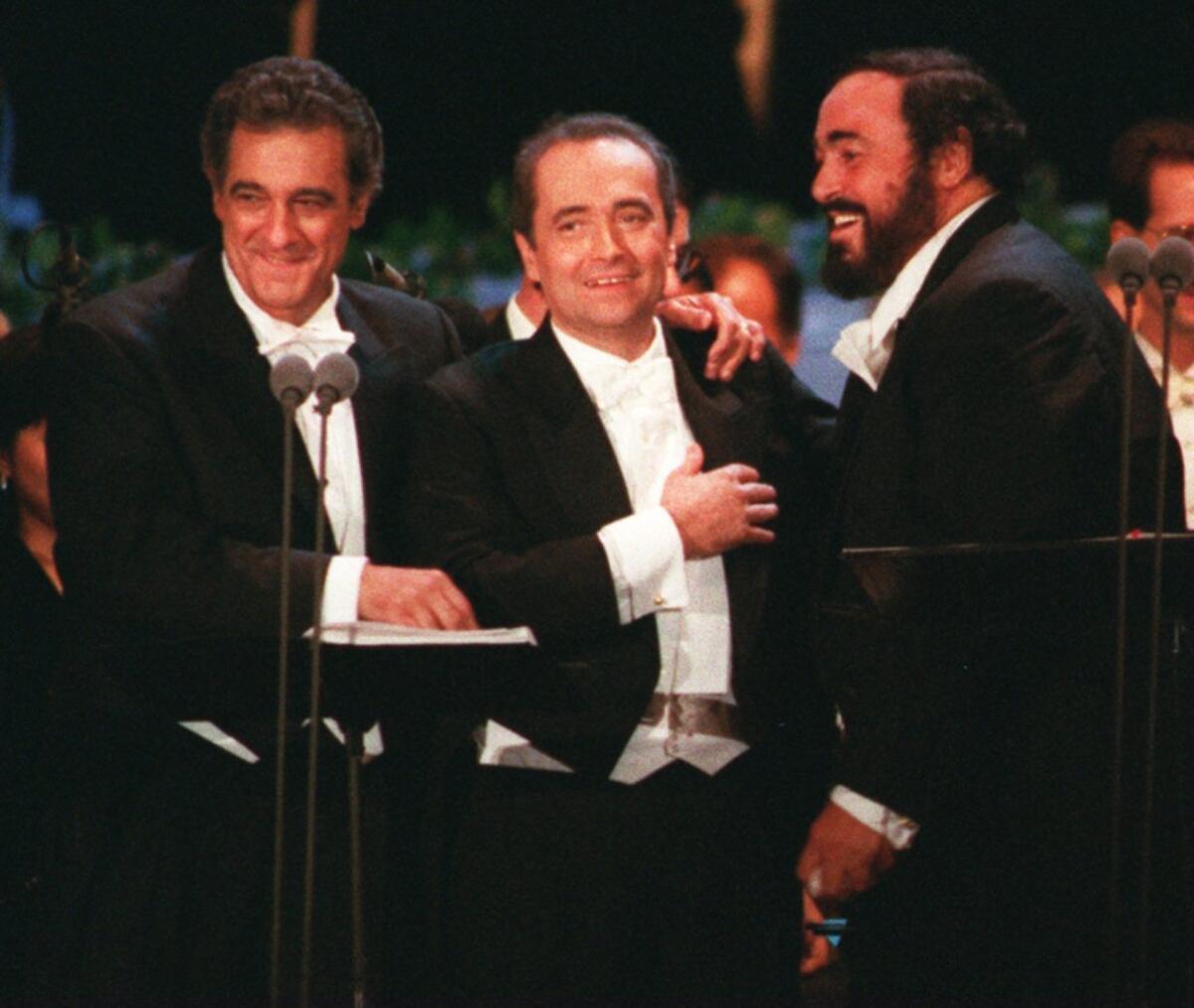
- Show more sharing options
- Copy Link URL Copied!
One of the most popular and lucrative franchises in classical-music history, the Three Tenors was a cultural phenomenon, inspiring adoration among fans and disdain from music purists who regarded the enterprise as a shameless money grab.
The teaming of Plácido Domingo, José Carreras and Luciano Pavarotti performing operatic favorites and pop tunes did indeed generate a lot of money over several concerts, albums, DVDs and broadcasts. More than 1 billion viewers are estimated to have seen the concerts, in person and on television.
Even today, the franchise keeps on giving: Wednesday marks the 20th anniversary of the Three Tenors concert at Dodger Stadium, an event being celebrated by the release of a new DVD edition of the 1994 performance, which featured the three singers performing with the Los Angeles Philharmonic under the baton of Zubin Mehta.
The Three Tenors concerts were often programmed to coincide with the World Cup championships. (In 1994, the World Cup was held in the U.S., with the final match played at the Rose Bowl in Pasadena.) The Dodger Stadium concert was organized by Tibor Rudas, the Hungarian-born impresario known for his arena-style concerts.
The Los Angeles Times reported that top tickets went for about $1,000 and that more than 50,000 people were in attendance, nearly filling Dodger Stadium.
Former Times music critic Martin Bernheimer noted in his review that a traffic jam made him late for the start of the concert. The critic was unimpressed for the most part with the event, calling it a “megatenor show” and describing the three stars as “contenders for the universal Golden-Larynx award.”
He also faulted the concert’s audiovisual systems, which he said resulted in poor sound-image synchronization on the stadium’s DiamondVision screen.
His review incited a deluge of reader letters, some in support of the unkind assessment, but many more siding with the tenors. Later the same month, the Times reported that letters were running about five-to-one in taking issue with Bernheimer’s review.
Critics like to have the final word, and Bernheimer weighed in again the following month with a Times essay on the “monster concert” phenomenon. In the article, he criticized the promotional hype surrounding the event and accused the tenors of trivializing their art form.
In 1995, Wayne Baruch, the general manager for the Dodger Stadium concert, penned a humorous Times opinion piece titled “Time to Play Fair With Three Tenors,” in which he took the newspaper to task for its often disparaging coverage of the concert.
The new DVD release, from Warner Classics, features the actual concert at Dodger Stadium and a making-of documentary that shows the singers rehearsing for the show. The release also comes with a companion CD with some of the songs from the performance.
Loved or loathed, the Three Tenors are still with us, albeit only in digital spirit. (They gave their final concert more than a decade ago, and Pavarotti died in 2007.) Given the state of opera in the U.S. -- the Metropolitan Opera is in dire financial condition, while other companies struggle to survive -- the arguably crass populism of the Three Tenors may seem in retrospect like a small problem indeed.
Twitter: @DavidNgLAT
More to Read
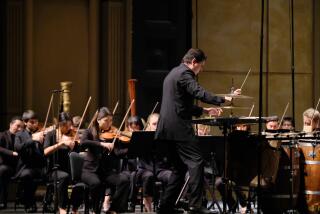
The collapse of the American Youth Symphony: Behind the closure of a beloved L.A. institution
May 8, 2024
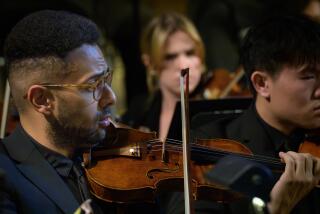
Civic Orchestra of Los Angeles: A new home for young talent pursuing a career in music

Opera gets slapped with the ‘elitist’ label. L.A. proves just how wrong that is
April 19, 2024
Entertainment & Arts
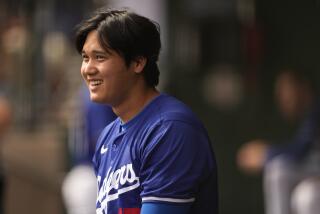
The Shohei Ohtani Effect: Dodgers ticket prices are soaring, both home and away
March 15, 2024

Happy 95th birthday, Frank Gehry. Let’s give you the Disney Hall you really wanted
Feb. 25, 2024
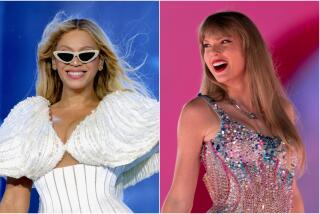
Company Town
The Tayoncé effect: Live Nation says concert attendance was up 20% in 2023
Feb. 23, 2024
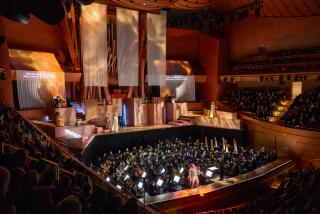
How Gustavo Dudamel, the L.A. Phil and Frank Gehry pulled off a very L.A. ‘Das Rheingold’
Jan. 27, 2024

Orel Hershiser discovers his inner holiday crooner in Christmas song collaboration
Dec. 25, 2023

The L.A. Phil just finished its best fall season in memory. How three maestros made magic
Dec. 20, 2023
The biggest entertainment stories
Get our big stories about Hollywood, film, television, music, arts, culture and more right in your inbox as soon as they publish.
You may occasionally receive promotional content from the Los Angeles Times.

David Ng is a former Company Town reporter for the Los Angeles Times.
More From the Los Angeles Times
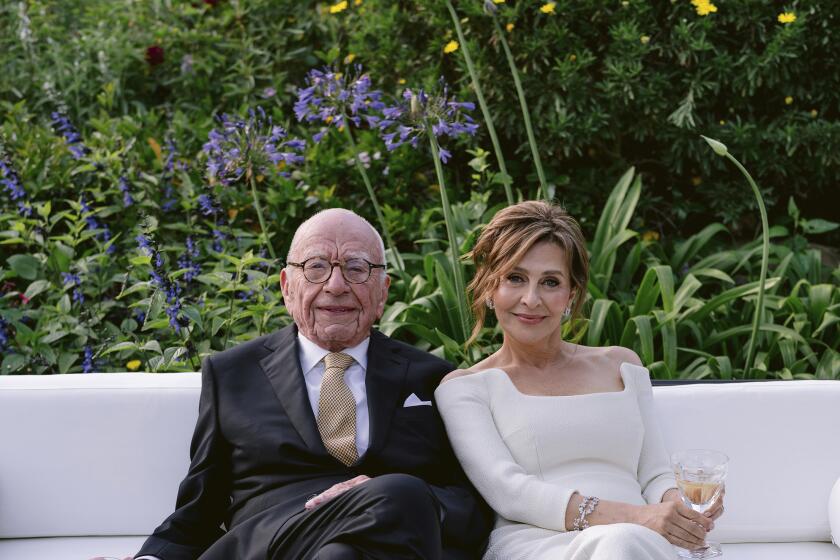
Rupert Murdoch marries for the fifth time, at his winery in Bel-Air

‘Garfield,’ ‘If’ and ‘Furiosa’ lead another lousy box office weekend
June 2, 2024
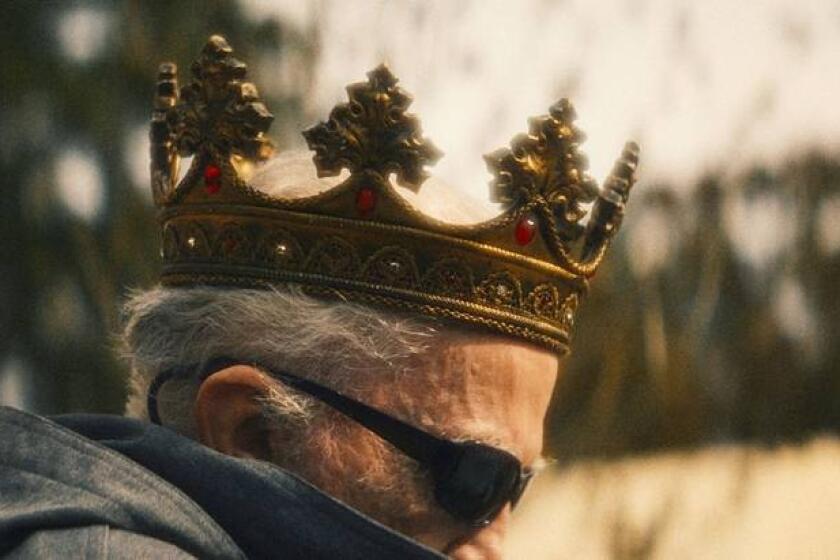
In HBO’s rewarding new docuseries, a power struggle at a Texas Renaissance faire


Review: Queer Black women shine at timely museum shows by Mickalene Thomas and Simone Leigh
June 1, 2024

- Latest News
‘Live And Dangerous’: Bottling Thin Lizzy’s Electric Energy
‘from the beginning’: untangling small faces’ complicated early years, ‘my love’ and ‘red rose speedway’: double top for paul mccartney & wings, ‘mulan’: a disney soundtrack fit for a warrior, ‘mp da last don’: when master p ruled the world, ‘when i dream’: crystal gayle storms the charts in 1978, ‘now & then’: the carpenters combine the new and the nostalgic, master p to release two 90s lps on vinyl, vengaboys announce ‘the greatest hits collection (we like to party)’, two classic 1990s snoop dogg albums are getting vinyl reissues, eminem interpolates steve miller band on new song, ‘houdini’, beastie boys announce 30th anniversary edition of ‘ill communication’, snow patrol announce new album ‘the forest is the path’, disney unveils new teaser trailer for ‘moana 2’, ‘the three tenors – 30th anniversary edition’ celebrating iconic concert announced.
To celebrate 30 years since The Three Tenors’ Rome concert that changed classical music forever a special CD/DVD set will be released in July.
Published on
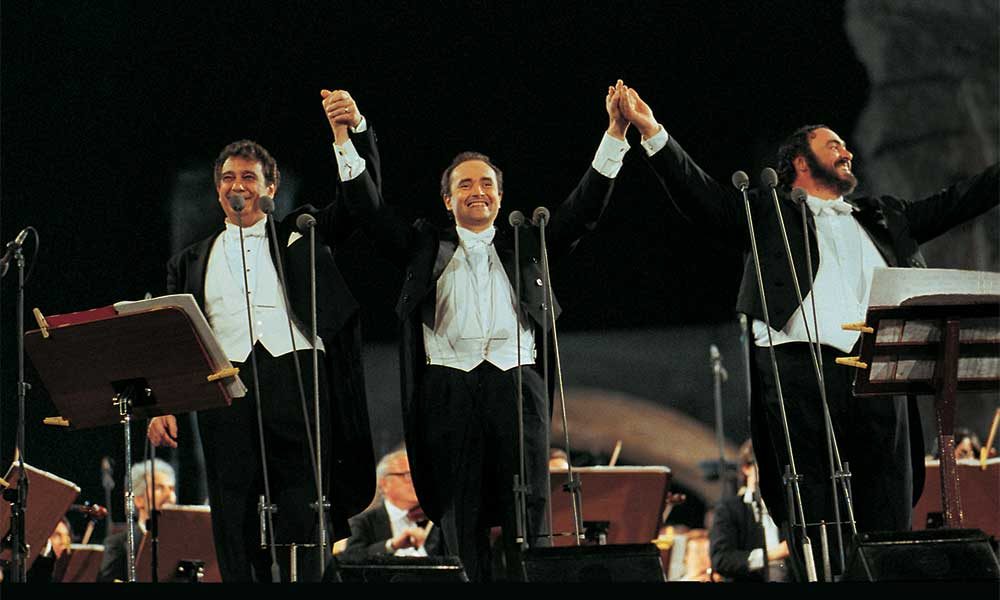
On the evening of 7 July 1990, set against the imposing backdrop of the ancient Baths of Caracalla in Rome, The Three Tenors, José Carreras, Plácido Domingo and Luciano Pavarotti, made history with their iconic concert that irrevocably changed classical music forever. Luciano Pavarotti noted, “For all three of us, the Caracalla concert was a major event in our lives. I hope I am not immodest to think it was also unforgettable for most of the people who were present.”
To mark 30 years since their legendary Rome concert, held on the eve of the 1990 FIFA World Cup final, The Three Tenors – 30th Anniversary Edition , a special CD/DVD set, featuring a CD of the original concert and a DVD of the complete concert, including a “making of” documentary, will be released on 24 July 2020. The collectors booklet features new liner notes and many photos from the event and behind the scenes.
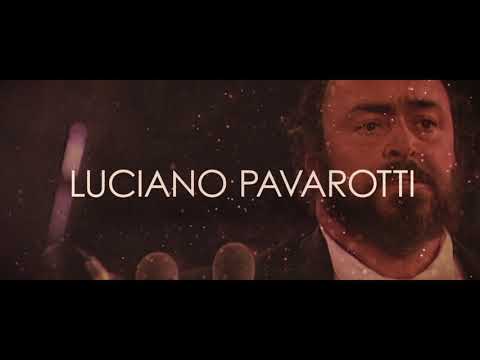
Zubin Mehta, who led the orchestras of the Maggio Musicale Fiorentino and Teatro dell’Opera di Roma, recalled, “I remember with greatest pleasure this concert with the greatest singing artists of our time. The concert in Rome was a unique experience, one I will never forget!”
The Three Tenors shared the stage, and the spotlight, to perform songs including Puccini’s ‘Nessun Dorma’, pantomiming a friendly rivalry and creating one of the most successful classical music concerts of all time. Over the last 30 years, ‘Nessun Dorma’ has become synonymous with moments of unity and celebration in sport, film and television. The aria, originally released by Luciano Pavarotti in 1972 and used as the theme music for the BBC’s coverage of the World Cup, was performed twice during the Rome concert – once as a solo, and again as an encore, when Pavarotti was joined by Carreras and Domingo.
The original live album of the concert Carreras Domingo Pavarotti In Concert , won the Grammy Award for Best Classical Vocal Performance in 1991 and remains the best-selling classical album of all time. Since their debut The Three Tenors achieved critical and cultural acclaim and enjoyed world tours and special performances throughout the 1990s and 2000s. Their debut concert in Rome was the beginning of instant and global fame for the trio whose repertoire ranged from opera arias to Neapolitan ballads, Broadway hits and pop songs.
From 7 July 1990 José Carreras, Plácido Domingo and Luciano Pavarotti reached out and conquered a much wider public – one that would never, collectively, have fitted inside all of the world’s opera houses put together, but who now felt that they had, in some way, experienced the genre and who would surely have said that they liked – perhaps even loved – opera.
The Three Tenors’ 30th anniversary is also marked by the release of a television documentary, released by C-Major Entertainment. In addition, the original concert footage will be made available on all major video streaming services, and a Blu-ray edition of the concert and the new documentary will be released later this year.
As opera houses remain silent and football stadiums are empty of supporters, fans can relive the moment history was made by The Three Tenors in Rome 1990, and remember the night when the ‘Beautiful Game’ and classical music crossed a cultural divide and changed the music industry forever.
The Three Tenors – 30th Anniversary Edition will be released on 24 July 2020 and can be pre-ordered here .
Do you want to be the first to hear the latest news from the classical world? Follow uDiscover Classical on Facebook and Twitter .
Your email address will not be published. Required fields are marked *
Save my name, email, and website in this browser for the next time I comment.
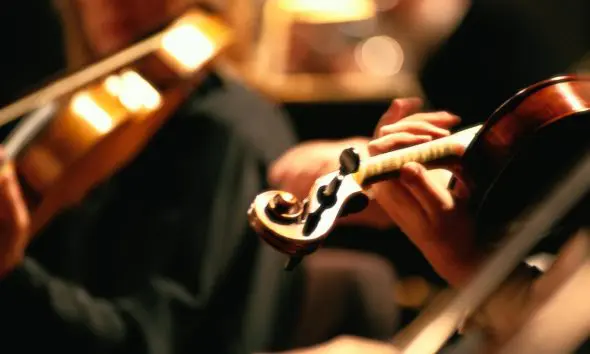
- Like OperaWire on Facebook
- Follow OperaWire on Twitter
- Follow OperaWire on Instagram
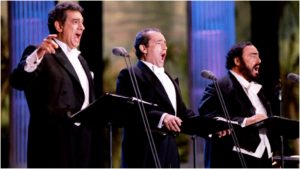
Relive The 4 Iconic World Cup Concerts Of The Three Tenors
The World Cup kicks off tomorrow with a match between Russia and Saudi Arabia.
Before that, audiences around the world will get to clamor as some of the greatest opera stars appear on the world stage. And then on the opening ceremony, another young opera star will make a major appearance .
For some, the concept of opera and soccer (football around the rest of the planet) seem like an odd fit. And yet, it was the World Cup itself that brought us one of the most famous ensembles ever – The Three Tenors.
The trio of Plácido Domingo, José Carreras, and, of course, Luciano Pavarotti is more famous and renowned than most other music groups to come and go throughout the 20 th century. They infiltrated pop culture like few other artists ever have and completely changed the way people view opera. It was Pavarotti’s rendition of “Nessun Dorma” that made it so iconic. It was the multi-singer interpretation of “O Sole Mio” that is widely imitated these days.
So here’s a look back at the World Cup concerts that remain so iconic to this day.
July 7, 1990 – World Cup in Italy
This is where it all started. The three appeared at the Baths of Caracalla and gave a taste of what would come for over 13 years. This is where we famously heard the group perform “Nessun Dorma” together for the first time. Or the first time they pitched in together to sing “O Sole Mio.” Both of these, by the way, were encores. The rest of the program is a mix of Spanish and Italian songs with two French selections and one in German. Zubin Mehta conducted.
This was just the third concert in three years to feature the ensemble. Again, Zubin Mehta led the concert at Dodger Stadium. It was the first of the Three Tenors’ appearances at a sporting venue, which was actually a point of contention in a review. Nonetheless, they would go on to perform at a dozen sporting venues after. This concert also featured some of the expected hits (“Nessun Dorma,” “Granada,”) but also featured a wider range of repertoire. There are a lot of American hits such as “Singin’ in the Rain,” “All I Ask of You,” “America,” “My Way,” and “Be My Love,” among others.
Under the baton of James Levine, the trio reconvened for what was now its 18 th concert. They were a world-wide phenomenon and the concert prior to the World Cup Final was now a tradition of sorts. This concert took place on the Champs de Mars in front of the Tour Eiffel and the concert was televised to tremendous acclaim. This concert also featured some expected hits (“Nessun Dorma” and “O Sole Mio”) but was far more varied in its selection of more popular tunes. Unlike the previous two installments at the World Cup, there aren’t many opera arias. Don’t miss Pavarotti sing “Granada,” which had been a staple of Domingo (1994) and Carreras (1990) in previous concerts.
June 27, 2002 – World Cup in Japan / Korea
This was the 31 st concert of The Three Tenors and their final appearance together at a World Cup. They would have three more concerts thereafter, but this one is different and special. Unlike the other three World Cup concerts, this one was never released on video or CD. The tenors are far from their best (Pavarotti himself had already announced his upcoming retirement), but what is most fascinating is that it does not only include the Three Tenors, but also features local artists. This concert features more standard repertoire that harkens back to that first concert 12 years earlier, giving everything a sense of coming full circle.
Opera Meets Film: Zhang Yimou & Zubin Mehta’s ‘Turandot At The Forbidden City’

Unveiling the Therapeutic Power of Opera: How Opera Positively Impacts Us

Artist of the Week: Charles Castronovo

30 - 02 Jun 2024
European Open
Green Eagle Golf Courses, Hamburg, Germany

DP World Tour Partners

Madonna sued for "pornography without warning" and for "deceptively" marketing her world tour
This is the second lawsuit leveled at the singer for her celebration world tour, by nardos haile.
Madonna 's Celebration world tour is at the center of yet another controversy.
According to People Magazine , in a class action lawsuit filed on Thursday, the singer is being sued by a fan who said Madonna subjected concertgoers to watch "pornography without warning." They are alleging claims of negligent misrepresentation, intentional infliction of emotional distress, breach of contract and false advertising.
Moreover, the lawsuit claimed that during Madonna's March 7 concert in Los Angeles, there were "topless women on stage simulating sex acts," while detailing a concertgoing experience that was "hot" and "uncomfortable" due to the lack of air conditioning. The fan alleged that Madonna ordered the air conditioning to be turned off, and as a result of no air conditioning, he says he became physically ill because of the heat, Entertainment Weekly reported.
Throughout her career, Madonna has cultivated a sex-positivite persona. Her shows have included erotic dancing, suggestive touching and lap dances that would include singers such as Maluma and Ricky Martin, People said. Alongside Madonna, the plaintiff also has also named the entertainment company, Live Nation, owner of Ticketmaster for luring concertgoers into purchasing "expensive tickets" and “purposely and deceptively” concealing information about the singer's show not starting on time as it was marketed.
The complaint stated that the show was marketed to start at 8:30 p.m. but Madonna didn't take the stage until after 10 p.m. However, when the singer eventually appeared on stage, the lawsuit claimed she was lip-syncing even though the concertgoers had paid for a live experience and performance.
"Forcing consumers to wait hours in hot, uncomfortable arenas and subjecting them to pornography without warning is demonstrative of Madonna's flippant disrespect for her fans," the complaint said. Madonna and her legal team have not yet responded to multiple requests to comment.
Madonna's alleged tardiness is also the reason for a previous lawsuit filed against the singer in January . Two concertgoers at one of her New York tour dates accused the singer of "unconscionable, unfair, and/or deceptive trade practices" for beginning her show at 10:30 p.m. instead of the marketed time of 8:30 p.m. At the time, Madonna's representatives said the show's delay was due to technical difficulties.
We need your help to stay independent
Last month, Madonna's attorneys filed a motion to dismiss the lawsuit, stating that "no reasonable concertgoer — and certainly no Madonna fan — would expect the headline act at a major arena concert to take the stage at the ticketed event time."
Madonna's alleged sexual performances and tardiness are not the only controversial moments during her Celebration tour. In March, the singer called out an audience member sitting down during her show. In a video recorded by a concertgoer, the singer was heard yelling from the stage, "What are you doing sitting down?" to suggest that audience members should be standing and or dancing. She realized her mistake when she looked at the audience member who was in a wheelchair.
The singer said on stage, “Oh, OK. Politically incorrect, sorry about that. I’m glad you’re here." However, Madonna's actions was met with backlash. Criticisms online stated that her comments were "pure ableism & glaring privilege."
about Madonna
- The unreasonable, degrading expectations imposed on stars' bodies
- Did Madonna's "I'm gay" TikTok really mean what we think it means?
- Madonna at 60: From Material Girl to Golden Girl, on her own terms
Nardos Haile is a staff writer at Salon covering culture. She’s previously covered all things entertainment, music, fashion and celebrity culture at The Associated Press. She resides in Brooklyn, NY.
Related Topics ------------------------------------------
Related articles.
More From Forbes
Strap on your snowshoes for a tour of tahoe’s gray’s crossing.
- Share to Facebook
- Share to Twitter
- Share to Linkedin
The final neighborhood of the Truckee development, the Village, launched 24 new modern mountain ... [+] residences.
When shopping for a mountain home site near Truckee, California, Liza and John Killen strapped on their snowshoes. “We trekked through the forest with our poles, rounded a corner and there it was: a straight-on view of Lookout Mountain,” Liza Killen recalls.
The couple were soon snug in their great room, its vaulted ceiling framing a snowy vista of the Sierra Nevada mountain range from their four-bedroom home built in the en vogue mountain modern style : glass-rich, with clean lines and rugged, rustic textures. Theirs was among the first constructions in Gray’s Crossing , a 750-acre planned community that launched in 2004 with around 400 home sites. The development, a 15-minute drive from Lake Tahoe, is wreathed by a dozen-plus ski resorts. One of them, Palisades Tahoe, hosted the 1960 Winter Olympic Games.
The 750-acre planned community launched in 2004 with around 400 home sites.
The Killens represent California’s new property gold rush: Silicon Valley tech workers who purchase primary and secondary homes in the Lake Tahoe region (John Killen works in process mining). Trading a cubicle for a home office with mountain views? A no-brainer.
“Gray’s Crossing homeowners are almost entirely from the San Francisco Bay Area,” says Jeff Brown , owner and general manager of Tahoe Mountain Realty . “It’s all tech and finance around tech. Truckee and Gray’s Crossing have become the archetype for remote work migration.”
Samsung Documents Confirm Missing Galaxy Z Fold 6 Feature
World no 1 djokovic survives 5 set epic to advance in french open match that ends after 3 am, ufc 302 results bonus winners after special main event performance.
Pricing ranges from $1.85 million and $2.365 million.
A Snowy Mountain Village
The Killens live in The Bluffs, one of five distinct Gray’s Crossing neighborhoods that collectively enjoy a mountain of amenities: 13 miles of trails through forests and meadows, cozy lodges, fitness centers, pools, a ski valet, tennis, golf and restaurants.
The development’s newest and final neighborhood is aptly called The Village . Picture a quaint hamlet hidden in a pine and fir forest with live/work spaces, park, shops, market, cafe and a boutique hotel. Lining the curved road: 24 turnkey duplex homes ranging from approximately 1,900 to 2,500 square feet. The first commercial buildings will break ground in a few months. Twelve properties will be ready for occupancy this year, priced between $1.85 million and $2.365 million.
The 2024 release offers a collection of brand new residences overlooking the fairways of the Golf ... [+] Club of Gray’s Crossing course.
The homes’ great rooms soar with glass, the glow from fireplaces burnishing walnut and white-oak cabinetry and flooring. The turnkey homes include furniture, area rugs, everything down to the throw pillows. Tahoe Modern provides homeowners with a vast catalog of decor selections, even art. But the real masterpiece is the snow-capped Sierra Nevada range that unspools just beyond walls of windows. That view includes the Peter Jacobsen/Jim Hardy championship golf course , a welcome reminder that winter isn’t the only season for mountain pursuits.
“The Village will anchor the entire Gray’s Crossing community,” Brown says. “It’s a place for neighbors to gather, sip a matcha and have a nice long chat.” Or maybe a nice short putt.
The Village home collection offers 4 unique floor plans.
Mountain Modern Styles: Urbane to Cozy
Home hunters (snowshoes not required) can choose from four styles: Manzanita, Ponderosa, Sage Brush or Aspen, which is now sold out. Sage Brush has three bedrooms and the other styles have four. The two-story homes with double garages are smartly clad in wood and metal, although glass predominates.
Looking for something a bit urban? Choose Ponderosa with its lengthy lines clad in charcoal-gray rib metal. Woodsy but decidedly elegant? The Manzanita’s cladding soars with cedar board siding. Cozy and chic? Sage Brush is built around basic box shapes with glass that ascends to the rafters.
Interiors are made bold by natural material accents.
Clare Walton , one of Lake Tahoe’s most renowned architects, designed the homes. ”Walton's structures look and feel organic,” writes a reviewer for Western Art & Architecture magazine. “As if they grew where they stand, shaped and weathered by the forces of nature.”
The home package includes all exterior maintenance “and fire insurance, which is a big deal in California,” Brown says. “It’s all bundled into the HOA [homeowners’ association fees]. The homeowner doesn’t have to deal with any of that.”
Owners also don’t have to contend with steep mountain roads slick with ice and snow—the development is sited on a level meadow. “Gray’s Crossing is very bright, very sunny,” Brown says. “That helps the snow melt a bit faster.”
Views from PJ's Restaurant encompasses Mt. Rose.
Tahoe Mountain Club
Amenity central for Gray’s Crossing residents is Tahoe Mountain Club , a members-only collection of lodges, restaurants and event and fitness facilities located within and without the community.
First up: the Alpine Club at the base of the Northstar California ski resort, about six miles from Gray’s Crossing. The club includes a ski valet w i th seasonal equipment storage (no need to lug skis, poles and boots back and forth to the resort). A restaurant and clubhouse with a roaring fire completes the high-altitude picture at 6,500 feet.
At the Gray’s Crossing development, PJ’s Restaurant is set against a vista of Mt. Rose. “The view, the setting, it almost defies words,” Brown says. “It overlooks a gorgeous mountain meadow crossed by a stream.” Circling above: red-tailed hawks. Brown’s favorite dish? Mahi Mahi tacos topped with chipotle crema and mango relish.
The Golf Club at Gray's Crossing features a Peter Jacobsen/Jim Hardy-designed championship golf ... [+] course.
Club members can also purchase passes for The Golf Club at Gray’s Crossing (development’s Peter Jacobsen/Jim Hardy course) or for Old Greenwood, a Jack Nicklaus-designed course in an adjacent community.
At Gray’s, community is central. The club holds 500+ events and activities every year: wine dinners, snow tubing, summer concerts, pool parties, kids’ scavenger hunts and beer and wine tastings, among others.
“Here, it’s really about the lifestyle, especially for families,” says Liza Killen, who has two teenage daughters. “Our family bikes and cross-country skis together, and the kids do lots of water sports. Last year, we planted sugar pine trees along the Sawtooth Trail. And every year we hike into the forest and cut down our own Christmas tree.”
Recreational facilities include fitness centers, pools and tennis courts.
A mere mile-and-a-half away from Gray’s: Truckee’s mountain-town vibe buzzes with shopping, nightlife and festivals.
“I love that I can shoot the kids down to the doctor or dentist, or get groceries right next door in Truckee,” Killen says. “At the same time, we’re surrounded by trees: 120 acres of open space right outside our backdoor.”
Liza Killen and Teddy Runge of Tahoe Mountain Realty hold the listing for the Village at Gray’s Crossing . Tahoe Mountain Realty is a member of Forbes Global Properties , a consortium of top-tier brokerages worldwide and the exclusive real estate partner of Forbes.
MORE FROM FORBES GLOBAL PROPERTIES

- Editorial Standards
- Reprints & Permissions
Join The Conversation
One Community. Many Voices. Create a free account to share your thoughts.
Forbes Community Guidelines
Our community is about connecting people through open and thoughtful conversations. We want our readers to share their views and exchange ideas and facts in a safe space.
In order to do so, please follow the posting rules in our site's Terms of Service. We've summarized some of those key rules below. Simply put, keep it civil.
Your post will be rejected if we notice that it seems to contain:
- False or intentionally out-of-context or misleading information
- Insults, profanity, incoherent, obscene or inflammatory language or threats of any kind
- Attacks on the identity of other commenters or the article's author
- Content that otherwise violates our site's terms.
User accounts will be blocked if we notice or believe that users are engaged in:
- Continuous attempts to re-post comments that have been previously moderated/rejected
- Racist, sexist, homophobic or other discriminatory comments
- Attempts or tactics that put the site security at risk
- Actions that otherwise violate our site's terms.
So, how can you be a power user?
- Stay on topic and share your insights
- Feel free to be clear and thoughtful to get your point across
- ‘Like’ or ‘Dislike’ to show your point of view.
- Protect your community.
- Use the report tool to alert us when someone breaks the rules.
Thanks for reading our community guidelines. Please read the full list of posting rules found in our site's Terms of Service.
11 AAPI celebrities who are changing Hollywood
- As AAPI Heritage Month draws to a close, these are some of the most famous AAPI celebrities today.
- Dwayne Johnson, who is Samoan, has been the highest-earning actor in Hollywood multiple times.
- Ali Wong, who is Vietnamese and Chinese, made history with her Emmy win.

May is AAPI Heritage Month . AAPI stands for Asian American and Pacific Islanders, a population that encompasses millions of people throughout the US from all over Asia, the Indian subcontinent, and the Pacific Islands, such as Samoa, Hawaii, and other Polynesian islands.
As AAPI Heritage Month concludes, we took a look at some of the most influential AAPI celebrities in Hollywood, including actors, directors, producers, and musicians. All have broken records and broken boundaries in terms of AAPI representation on-screen, behind the scenes, and on the radio.
Here are some of the most famous AAPI celebrities who are changing the entertainment industry.
Dwayne Johnson has been the highest-paid actor in Hollywood four separate times.
As reported by Forbes , Dwayne Johnson was the highest-paid actor in 2016, 2019, 2020, and 2021 for his roles in films such as "Central Intelligence," "Moana," "Jumanji: The Next Level," "Hobbs & Shaw," "Jungle Cruise," and "Red Notice."
The former pro wrestler is now one of the most famous people in the world and a face of the Samoan community in mainstream entertainment.
In addition to Johnson's movie roles , he is also a producer of many of his films, and he co-created a sitcom about his life growing up in Hawaii, his time at high school in Pennsylvania, and as a college student in Miami. Fittingly, it was called "Young Rock" and aired from 2021 to 2023.
Mindy Kaling has created multiple successful shows.
Mindy Kaling is one of the most influential showrunners in streaming right now. After starring on "The Office" (which she also wrote for), Kaling co-created and starred in her own sitcom, "The Mindy Project," which aired for six seasons.
Since, Kaling has somewhat stepped back from acting and is now focused on developing TV. Her Netflix series " Never Have I Ever " was a huge hit until it wrapped up in 2023. Her next hit, the Max series "The Sex Lives of College Girls," was responsible for introducing audiences to Renee Rapp , now a star in her own right.
Kaling also co-created the animated series " Velma ," which was almost universally hated … but got enough people hate-watching to greenlight a second season.
Two more shows created by Kaling are set to hit streamers soon: A comedy on Hulu called "Murray Hill" about 20-somethings in NYC and "Running Point," a Netflix comedy series starring Kate Hudson as the new president of a fictional Los Angeles NBA team.
Olivia Rodrigo is currently on a mega-successful world tour for her second album, "Guts."
Rodrigo, who is just 21 years old, has been hailed as the future of pop music after her stratospheric rise in 2021 due to her debut single, "Drivers License."
Since then, Rodrigo has released two chart-topping albums, won three Grammys, was named Time's entertainer of the year, and gracefully exited the Disney+ series that gave her a platform, "High School Musical: The Musical: The Series."
She also became the first Filipino-American to be featured on the cover of US Vogue in July 2023, according to Next Shark.
Director Jon M. Chu is gearing up for the release of "Wicked" this fall.
Chu is a high-profile director who has helmed multiple big-budget productions — besides the two-part "Wicked" adaptation, Chu directed Justin Bieber's concert film "Never Say Never," "In the Heights," "Now You See Me 2," and most famously, 2018's " Crazy Rich Asians ," the first modern-day major studio film featuring an Asian cast since "The Joy Luck Club" 25 years prior.
"Crazy Rich Asians" made $239 million worldwide, which is significant for a rom-com considering many consider the genre dead.
Now, he keeps fans hyped for " Wicked " this fall by posting photos from set, engaging with people online, and praising how amazing the cast is.
Steven Yeun is an Oscar nominee and an Emmy winner.
It might've taken a bit for Yeun's career to rebound after his character Glenn was killed off "The Walking Dead," but it was worth the wait. Since he exited the show in 2016, his career has only skyrocketed.
Yeun was nominated for an Academy Award (best actor) in 2021 for his performance in "Minari," making him the first Asian-American actor to ever be nominated in that category.
In 2023, he starred in and executive-produced the Netflix series " Beef ." He won two Emmys, two Golden Globes, two Critics' Choice Awards, and an Independent Spirit Award for the show.
The Korean-American actor also plays the super-powered teen Mark Grayson on the critically acclaimed Prime Video series "Invincible."
Ali Wong has also won numerous awards for "Beef."
Wong also won two Emmys and two Golden Globes for "Beef," making her the first Asian woman to win the Emmy for outstanding lead actress in a limited series or movie.
In addition to "Beef," Wong has produced three stand-up comedy specials. In the first one, "Baby Cobra," Wong was 7 ½ months pregnant and making dirtier jokes than almost anyone else, pushing the boundaries of what stand-up comedy can be.
Wong also wrote and starred in her own rom-com, "Always Be My Maybe," and cast Keanu Reeves as her love interest, a true power move.
Priyanka Chopra is the most-followed Indian actor on Instagram.
Chopra, who won Miss World in 2000, has become a powerhouse in both India and the US. In 2012, she became first Bollywood star to sign with the American talent agency CAA.
Since then, she's cultivated a massive Instagram following (91.1 million followers and counting), has become a lifestyle figure (with a hair-care line, an NYC restaurant, and a home-goods line), wrote a best-selling memoir, and is a successful actor and producer.
In 2020, Chopra signed a "a two-year multimillion-dollar first-look television deal with Amazon," Variety reported. Her first project after the deal was the 2023 spy thriller series "Citadel," with a second season already on the way.
Bowen Yang is the last true "SNL" breakout we've had in years.
Yang, who joined the cast of the sketch show in 2019, is a star. The first Chinese-American comedian to ever join the show, Yang almost immediately cemented himself as an important addition to the cast. He's already been nominated for three Emmys (one for writing, two for acting).
He's also branched out into movies, appearing in "The Lost City," "Fire Island," and "Bros." Later this year, he has a supporting role in "Wicked," and is set to remake the Ang Lee rom-com "The Wedding Banquet" alongside recent Oscar nominee Lily Gladstone.
Chloé Zhao was the first woman of color to win best director at the Oscars (and the second woman ever).
Zhao made history in 2021 when she won best director for her film "Nomadland." She was the second woman to ever win that award, behind Kathryn Bigelow in 2010, and the first Asian woman to owin.
Following "Nomadland," Zhao directed the MCU film "Eternals," which made a respectable $402 million at the box office, even though it wasn't a huge hit with critics or fans.
Next up for Zhao is an adaptation of the hit novel "Hamnet," starring Paul Mescal and Jessie Buckley, Deadline reported.
Auli'i Cravalho is the voice of the first Polynesian Disney princess.
Cravalho made her film debut in 2016 as the voice of Moana, the first Polynesian Disney princess, a huge step forward in AAPI representation at Disney. She'll return to the role in 2024 for "Moana 2."
And though she won't play Moana in the live-action film in order to "pass the baton to the next young woman of Pacific Island descent," as she told The Wrap , she will produce the film alongside Dwayne Johnson.
Cravalho is also a live-action star, recently appearing in the musical film adaptation of "Mean Girls" and the Hulu rom-com "Crush."
Dev Patel made his directorial debut in 2024.
In addition to the internet demanding he be cast as the next James Bond, Patel is a busy guy. After starring in the runaway hit "Slumdog Millionaire," Patel has been one of the most reliable (and charming) stars in Hollywood.
He was nominated for an Oscar in 2017 for his performance in "Lion," starred in the Middle Ages epic "The Green Knight," collaborated with Wes Anderson for the Oscar-winning short film "The Wonderful Story of Henry Sugar," and made his directorial debut with the action film "Monkey Man." He also stars in the film.
- Main content
- Milano Cortina 2026
- Brisbane 2032
- Olympic Refuge Foundation
- Olympic Games
- Olympic Channel
- Let's Move
World No.1 An Se-young and No.2 Shi Yuqi claim singles titles at Singapore Open
An and Shi needed three games to overtake their opponents and remain at the top of the rankings heading into the final tournaments before Paris 2024.
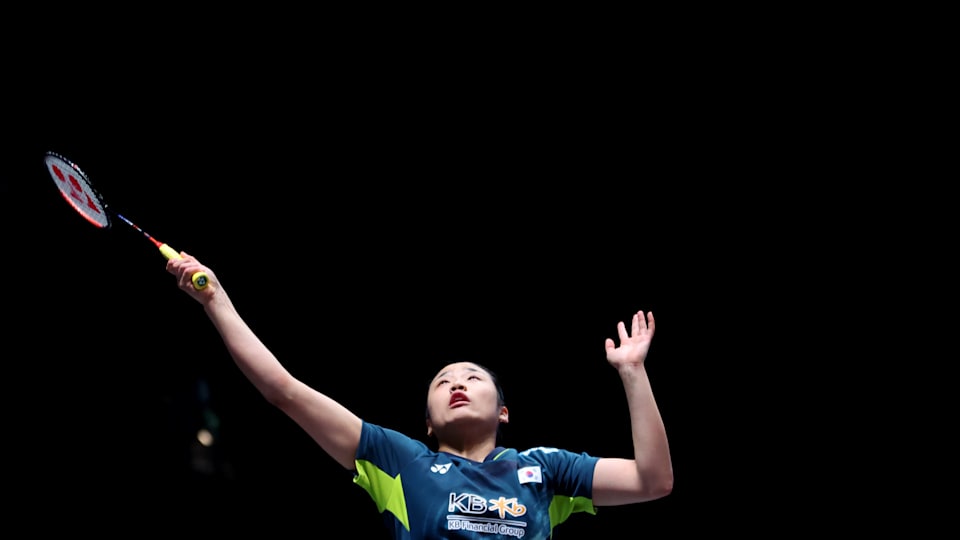
World No.1 An Se-young and world No.2 Shi Yuqi showed top form again at the Singapore Open, winning a third and fourth major title of the year, respectively, on Sunday (2 June).
Displaying her fighting spirit, An took 77 minutes and three games to edge past Olympic badminton champion Chen Yu Fei of the People’s Republic of China.
An defended her narrow lead in the first game to take it 21-19, but fell quickly behind in the second. Coming back for the deciding game, the Republic of Korea's star quickly raked up a sufficient lead to run off with the win and her third title of the year.
She previously won the Malaysia Open in January and the French Open in March.
- An Se-young exclusive: "If you think of it as pressure, it becomes pressure"
- How to qualify for badminton at Paris 2024
Over in the men's singles event, it was a duel of teammates with Shi Yuqi and Li Shifeng , both of the People’s Republic of China, battling for the top honours.
Li claimed the first game, but Shi trailed him closely in the second and ultimately took it 21-19. The third proved a rollercoaster of emotions as Li soared ahead by seven points midway only for Shi to catch up and overtake him in the final two points.
With this victory in Singapore, Shi adds to his three earlier titles this year, from the French Open, India Open and Malaysia Open.
Results from finals day at the BWF World Tour Singapore Open:
Mixed doubles: Zheng Si Wei/Huang Ya Qiong (CHN) def. Yang Po-Hsuan/Hu Ling Fang (TPE) 21-11, 21-19
Women’s doubles: Chen Qing Chen/Jia Yi Fan (CHN) def. Matsuyama Nami/Shida Chiharu (JPN) 21-15, 21-12
Women’s singles: An Se-young (KOR) def. Chen Yu Fei (CHN) 21-19, 16-21, 21-12
Men’s singles: Shi Yuqi (CHN) def. Li Shifeng (CHN) 17-21, 21-19, 21-19
Men’s doubles: He Ji Ting/Ren Xiang Yu (CHN) def. Fajar Alfian/Muhammad Rian Ardianto (INA) 21-19, 21-14

Related content

BWF Singapore Open 2024: Viktor Axelsen pulls out of semis with injury

BWF Singapore Open 2024: Loh Kean Yew and Carolina Marin eliminated

BWF Singapore Open 2024: Jonatan Christie suffers early exit, Lee Zii Jia concedes walkover

Chen Yufei's journey from 10-year-old fan to World number 1
You may like.

IMAGES
VIDEO
COMMENTS
The Three Tenors were an operatic singing trio, active between 1990 and 2003, and termed a supergroup (a title normally reserved for rock and pop groups) consisting of Italian Luciano Pavarotti and Spaniards Plácido Domingo and José Carreras. ... The Three Tenors opened a world tour of concerts during 1996-1997.
The Three Tenors' legendary first joint performance took place at Rome's Terme di Caracalla on July 7, 1990. The trio, Plácido Domingo, José Carreras, and Luciano Pavarotti, whose repertoire ...
Who were the Three Tenors? A guide to Pavarotti, Domingo and Carreras - Classical Music. When Plácido Domingo, Luciano Pavarotti and José Carreras performed together before the 1990 World Cup Final, they changed the course of classical music.
As the encore of their magnificent 1994 concert, The Three Tenors joined together for Puccini's "Nessun Dorma", made famous in pop culture by Luciano Pavarot...
The Three Tenors joined to conquer. When this trio of famous opera singers — José Carreras, Placido Domingo and Luciano Pavarotti — gave a one-night-only show at Los Angeles' Dodger Stadium ...
Carreras Domingo Pavarotti in Concert (re-released as The Three Tenors in Concert) is a live album by José Carreras, Plácido Domingo and Luciano Pavarotti with conductor Zubin Mehta.The album was recorded on 7 July 1990 in Rome, Italy, as the first Three Tenors concert with the orchestra of the Maggio Musicale Fiorentino and the orchestra of Teatro dell'Opera di Roma on the evening before ...
During its 25th anniversary year, take a look behind the scenes of The Three Tenors's monumental 1994 World Cup concert. The full performance is now availabl...
Join Luciano Pavarotti together with his friends and colleagues Plácido Domingo and José Carreras in the most successful classical music concert of all time: the incredible Three Tenors at the ancient Baths of Caracalla in Rome held on the eve of the 1990 FIFA World Cup final in Italy, with Zubin Mehta conducting the Orchestra del Maggio ...
3 Concerts. The Three Tenors is a name given to collaborative concerts of the three operatic tenors Plácido Domingo, José Carreras and Luciano Pavarotti. The trio began their collaboration with a debut concert at the ancient Baths of Caracalla in Rome held on the eve of the 1990 FIFA World Cup final in Italy, on July 7, 1990, with Zubin Mehta ...
The Three Tenors in 1996. From left, Plácido Domingo, José Carreras and Luciano Pavarotti. Mark J. Terrill/Associated Press. Now, at 70, he is retiring from singing, on a long world tour that ...
Jose Carreras, along with his two friends, Placido Domingo and Luciano Pavarotti, agreed to perform as the Three Tenors. Dradi's idea came to fruition on July 7, 1990, the day before the FIFA World Cup in Rome. The concert was watched by over 800 million viewers and was so well received that when a recording of the concert was released, it ...
It came to him at a big event, the 1994 sellout "Three Tenors" concert at Dodger Stadium in Los Angeles, an extravaganza beamed to 1.3 billion television viewers worldwide, four years after the ...
The Three Tenors in Concert 1994 is a live album by José Carreras, Plácido Domingo and Luciano Pavarotti with conductor Zubin Mehta.The album was recorded on July 16, 1994, at the Three Tenors concert in Los Angeles with the Los Angeles Philharmonic and the chorus of the Los Angeles Opera on the night before the 1994 FIFA World Cup Final. An estimated 1.3 billion viewers watched the concert ...
Carreras Domingo Pavarotti in Concert is a live album by José Carreras, Plácido Domingo and Luciano Pavarotti with conductor Zubin Mehta. The album was recorded on 7 July 1990 in Rome, Italy, as the first Three Tenors concert with the orchestra of the Maggio Musicale Fiorentino and the orchestra of Teatro dell'Opera di Roma on the evening before the 1990 FIFA World Cup Final.
José Carreras, Plàcido Domingo, and Luciano Pavarotti, with conductor Zubin Mehta, perform "A Tribute to Hollywood" medley at their legendary concert at the ...
The Three Tenors concerts were often programmed to coincide with the World Cup championships. (In 1994, the World Cup was held in the U.S., with the final match played at the Rose Bowl in Pasadena.)
The Three Tenors in Concert 1994. Playlist • Warner Classics • 2024. 523K views • 11 tracks • 2 hours, 3 minutes Perfomances by The Three Tenors from the legendary 1994 Concert. Featuring Nessun dorma, La donna è mobile, Brindisi, Ave Maria, My Way and many more. More.
The Three Tenors in Concert 1994 is a live album by José Carreras, Plácido Domingo and Luciano Pavarotti with conductor Zubin Mehta. The album was recorded on July 16, 1994, at the Three Tenors concert in Los Angeles with the Los Angeles Philharmonic and the chorus of the Los Angeles Opera on the night before the 1994 FIFA World Cup Final. An estimated 1.3 billion viewers watched the concert ...
To mark 30 years since their legendary Rome concert, held on the eve of the 1990 FIFA World Cup final, The Three Tenors - 30th Anniversary Edition, a special CD/DVD set, featuring a CD of the ...
July 16, 1994 - World Cup in USA. This was just the third concert in three years to feature the ensemble. Again, Zubin Mehta led the concert at Dodger Stadium. It was the first of the Three Tenors' appearances at a sporting venue, which was actually a point of contention in a review.
The Three Tenors joined to conquer. When this trio of famous opera singers — José Carreras,Placido Domingo and Luciano Pavarotti — gave a one-night-only show at Los Angeles' Dodger Stadium on ...
Guido Migliozzi birdied three of his last four holes in a bogey-free 67 to join Laurie Canter at the top of the leaderboard heading into the final round of the European Open.,
Two concertgoers at one of her New York tour dates accused the singer of "unconscionable, unfair, and/or deceptive trade practices" for beginning her show at 10:30 p.m. instead of the marketed ...
World No 1 Djokovic Survives 5 Set Epic To Advance In French Open Match That Ends After 3 AM Apple Insider Details An Expensive iPhone Pro Decision Pricing ranges from $1.85 million and $2.365 ...
Nicki Minaj will perform in 25 shows. You can view a list of the venues, locations and dates powered by Ticketmaster by clicking Ticketmaster Event Chart below. This chart's information may change, so please check the Nicki Minaj details page for the most up-to-date information. Ticketmaster may not ticket every venue.
(29 Jun 1996) English/NatThe three tenors - Jose Carreras, Placido Domingo and Luciano Pavarotti - are all set to kick off their world tour tonight (Saturda...
Chopra, who won Miss World in 2000, has become a powerhouse in both India and the US. In 2012, she became first Bollywood star to sign with the American talent agency CAA.
The Three Tenors were an operatic singing trio, active between 1990 and 2003, and termed a supergroup consisting of Italian Luciano Pavarotti and Spaniards Plácido Domingo and José Carreras. The trio began their collaboration with a performance at the ancient Baths of Caracalla in Rome, Italy, on 7 July 1990, the eve of the 1990 FIFA World Cup Final, watched by a global television audience ...
World No.1 An Se-young and world No.2 Shi Yuqi showed top form again at the Singapore Open, winning a third and fourth major title of the year, respectively, on Sunday (2 June).. Displaying her fighting spirit, An took 77 minutes and three games to edge past Olympic badminton champion Chen Yu Fei of the People's Republic of China.. An defended her narrow lead in the first game to take it 21 ...
Entry requirements are subject to change. By purchasing tickets to this event you agree to abide by entry requirements in effect at the time of the event. Check the venue website leading up to your event for the latest protocols. Find and buy Yuno Miles: Bringing Trash to The World Tour tickets at the The Shelter in Detroit, MI for Jul 18, 2024 ...